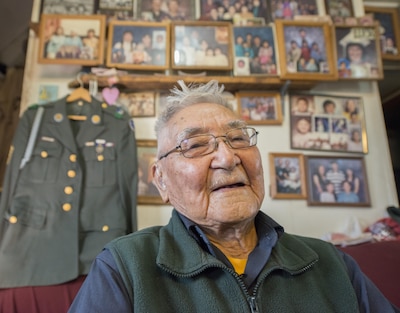By Sean Kimmons Army News Service
KWETHLUK, Alaska, Nov. 16, 2017 — When the Japanese raided
and occupied parts of Alaska during World War II, the Army called on native
Alaskans to defend the northern territory.
Given no pay, more than 6,300 Alaskans from 12 to 80 years
old signed on to be sentries for the newly created Alaska Territorial Guard.
Retired Army Sgt. 1st Class Sam Jackson, who still lives in
Kwethluk, a small village in southwestern Alaska, was one of them. Now 93, the
veteran recalled when Maj. Marvin Marston, an Army officer who formed the first
units of the ATG reserve component, asked him and others to join the cause.
"They called us the ears for the Army and eyes for the Army," said Jackson,
who served in the Alaska National Guard after the territorial guard disbanded
in 1947.
When Japanese forces invaded some of the Aleutian Islands in
June 1942, Marston was tasked to travel to Alaska and recruit members for the
new Army mission. He trekked across the tundra, often by dog sled in the
winter, to spread the word and round up troops for the Alaska Territorial
Guard, who were known as Eskimo Scouts.
Once enlisted, the Alaskan natives trained on Army tactics
so they could defend the territory from an attack, if needed. They even made
decoys using barrels and logs to resemble cannons to Japanese aircraft flying
overhead.
'Follow Your Training, Save Your Life'
At night, a blackout was practiced throughout the villages
to deter an enemy invasion. As a young man, Jackson said he helped keep the
windows of buildings covered so no light could be seen from the outside.
"They told us to follow your training and it will save
your life," Jackson said of his Army instructors, who supplied the scouts
with a rifle, uniform, snowshoes and other gear. "That's how we
trained."
Years later, Marston wrote in his book, "Men of the
Tundra: Alaska Eskimos at War," that the scouts proved helpful in
safeguarding terrain around the lend-lease air route, which the United States
used to supply aircraft to its Russian ally.
They also secured Platinum, an Alaskan village south of
Kwethluk, which was the only source of the strategic metal with the same name
in the Western Hemisphere. In addition, he wrote, they stockpiled survival
caches along vital transportation routes.
Recognized for Efforts
In 2010, the scouts were finally recognized for their
efforts and given veteran status when President George W. Bush signed a bill
into law that ordered the defense secretary to issue honorable discharges to
the Alaskan natives. Alaska's Department of Military and Veterans Affairs then
set up a task force to notify and assist former members, their families and
dependents on how to obtain the benefits entitled to them.
"Our goal is to locate 100 percent of the ATG members,
begin correcting the oversight of the past, and allow future generations access
to their ancestors' service records," according to the department's
website.
Soon after, federal funds were allocated to ensure the
actions of the thousands of Alaskans who volunteered to protect the territory
would not be forgotten.
Memorial Park
As statues and plaques began to be unveiled across the
state, a group of U.S. military veterans in nearby Bethel used the funds to
build a memorial park to enshrine the ATG veterans in 2012.
"They volunteered, some of them as young as 12, to
guard the people of western Alaska. There was no military presence here,"
said Stanley Rodgers, a former Army sergeant who served in the Vietnam War.
Born and raised in Bethel, Rodgers said he is related to
probably 70 former ATG members. Those relatives, he said, would tell him
stories of Japanese ships off the Bering Sea coast or of spies who had come
ashore. "Whatever they saw that was not appropriate, they would report it,"
he added. "Everyone was a sentry."
If the Japanese had invaded, he said, they would have faced
heavy resistance in a harsh land. "They would have never made it," he
said. "[The ATG] would have beaten them back."
As he stood next to a statue of an Eskimo Scout overlooking
a wall of plaques inside the memorial park, Rodgers said the place is not only
to honor what the scouts, like Jackson, did. It can also serve as a reminder of
selfless service for generations to come, he noted.
"It will be here forever," he said. "The
people may be gone, but the names will still be there."









No comments:
Post a Comment